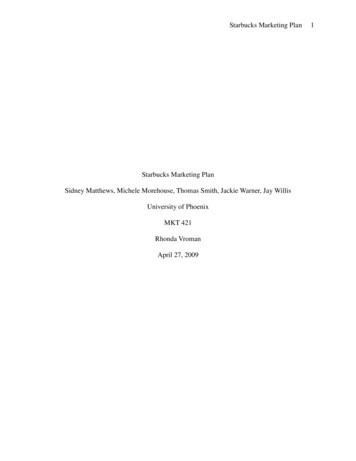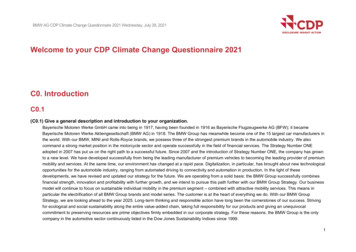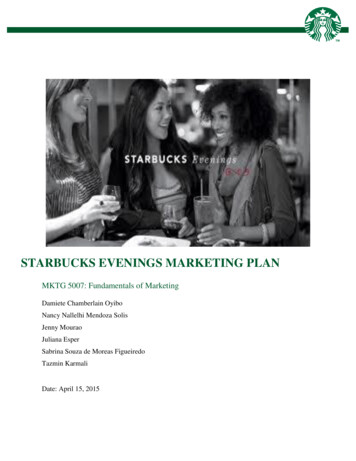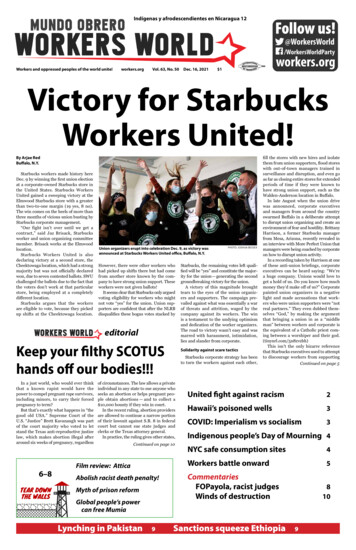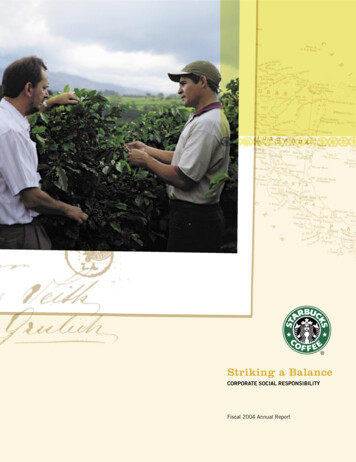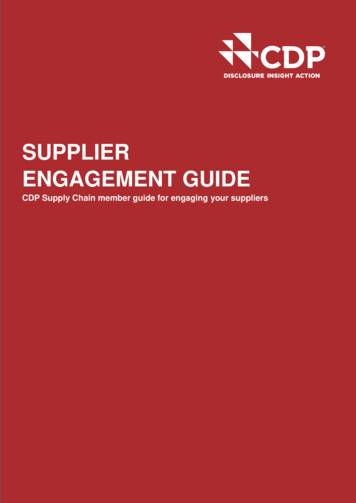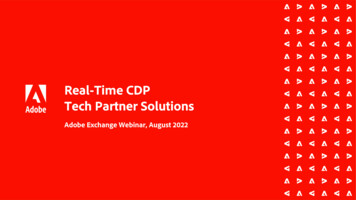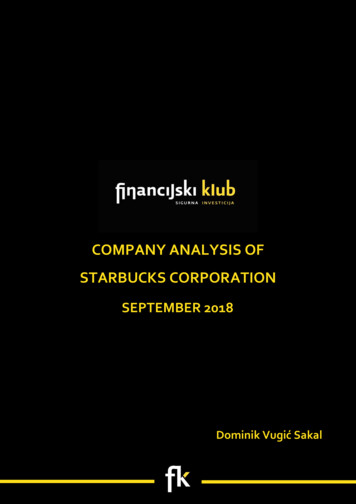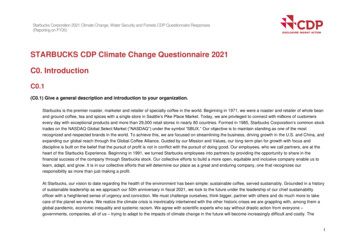
Transcription
Starbucks Corporation 2021 Climate Change, Water Security and Forests CDP Questionnaire Responses(Reporting on FY20)STARBUCKS CDP Climate Change Questionnaire 2021C0. IntroductionC0.1(C0.1) Give a general description and introduction to your organization.Starbucks is the premier roaster, marketer and retailer of specialty coffee in the world. Beginning in 1971, we were a roaster and retailer of whole beanand ground coffee, tea and spices with a single store in Seattle’s Pike Place Market. Today, we are privileged to connect with millions of customersevery day with exceptional products and more than 29,000 retail stores in nearly 80 countries. Formed in 1985, Starbucks Corporation’s common stocktrades on the NASDAQ Global Select Market (“NASDAQ”) under the symbol “SBUX.” Our objective is to maintain standing as one of the mostrecognized and respected brands in the world. To achieve this, we are focused on streamlining the business, driving growth in the U.S. and China, andexpanding our global reach through the Global Coffee Alliance. Guided by our Mission and Values, our long-term plan for growth with focus anddiscipline is built on the belief that the pursuit of profit is not in conflict with the pursuit of doing good. Our employees, who we call partners, are at theheart of the Starbucks Experience. Beginning in 1991, we turned Starbucks employees into partners by providing the opportunity to share in thefinancial success of the company through Starbucks stock. Our collective efforts to build a more open, equitable and inclusive company enable us tolearn, adapt, and grow. It is in our collective efforts that will determine our place as a great and enduring company, one that recognizes ourresponsibility as more than just making a profit.At Starbucks, our vision to date regarding the health of the environment has been simple: sustainable coffee, served sustainably. Grounded in a historyof sustainable leadership as we approach our 50th anniversary in fiscal 2021, we look to the future under the leadership of our chief sustainabilityofficer with a heightened sense of urgency and conviction. We must challenge ourselves, think bigger, partner with others and do much more to takecare of the planet we share. We realize the climate crisis is inextricably intertwined with the other historic crises we are grappling with, among them aglobal pandemic, economic inequality and systemic racism. We agree with scientific experts who say without drastic action from everyone –governments, companies, all of us – trying to adapt to the impacts of climate change in the future will become increasingly difficult and costly. The1
Starbucks Corporation 2021 Climate Change, Water Security and Forests CDP Questionnaire Responses(Reporting on FY20)impacts of climate change will take a toll on our supply chains, our business and more importantly, the lives of everyone involved, including coffeefarmers, our suppliers, Starbucks partners (employees), customers and the members of every community we serve. We also know that leadership insustainability takes commitment, investment, innovation, partnership and time. For these reasons, in January 2020, Starbucks chief executive officerunveiled a multi-decade aspiration to be a resource-positive company, giving more than it takes from the planet. The announcement included sciencebased preliminary target reductions of carbon, water and waste by 2030, and outlined five strategies the company has identified to move toward them.In March of 2021, our greenhouse gas reduction target was approved by the Science Based Targets Initiative (SBTi). Together, we are buildingStarbucks to be a great enduring company by staying true to our Mission & Values while boldly reimagining the future -- for our partners, ourcustomers, and for our planet.C0.2(C0.2) State the start and end date of the year for which you are reporting data.Reporting yearStart dateEnd dateIndicate if you are providing emissions data for past reporting yearsOctober 1, 2019September 30, 2020NoC0.3(C0.3) Select the countries/areas for which you will be supplying data.AustriaCanadaChinaItalyJapanSwitzerlandUnited Kingdom of Great Britain and Northern IrelandUnited States of America2
Starbucks Corporation 2021 Climate Change, Water Security and Forests CDP Questionnaire Responses(Reporting on FY20)C0.4(C0.4) Select the currency used for all financial information disclosed throughout your response.USDC0.5(C0.5) Select the option that describes the reporting boundary for which climate-related impacts on your business are beingreported. Note that this option should align with your chosen approach for consolidating your GHG inventory.Operational controlC1. GovernanceC1.1(C1.1) Is there board-level oversight of climate-related issues within your organization?YesC1.1a(C1.1a) Identify the position(s) (do not include any names) of the individual(s) on the board with responsibility for climate-relatedissues.Position ofindividual(s)Please explainBoard-levelcommitteeThe Nominating and Corporate Governance Committee is responsible for providing leadership with respect to the corporate governanceof Starbucks Corporation. This includes the responsibility to annually review and assess the effectiveness of the Company’senvironmental and social responsibility policies, goals and programs through the annual global environmental and social impact report3
Starbucks Corporation 2021 Climate Change, Water Security and Forests CDP Questionnaire Responses(Reporting on FY20)and make recommendations as deemed appropriate based on such review and assessment. An example of a climate-related decisionmade by the Nominating and Corporate Governance Committee in 2020 was the approval to go ahead with our public aspiration tobecome a resource positive company. Our commitment to a resource positive future emphasizes being a climate positive, water positive,and circular entity: storing more carbon than we emit, providing more clean, freshwater than we use, and eliminating waste. Ourpreliminary ambitious 2030 goals which accompanied this announcement, include: A 50% reduction in carbon emissions in our direct operations and supply chain; this target was approved by the Science Based TargetsInitiative (SBTi) in 2021; 50% of our water withdrawal for direct operations and coffee production will be conserved or replenished with a focus on communitiesand basins with high water risk; and A 50% reduction in waste sent to landfill from stores and manufacturing, driven by a broader shift toward a circular economy. Tounderscore this commitment, Starbucks has joined Ellen MacArthur Foundation’s New Plastics Economy Global Commitment, settingambitious circular targets for our packaging.C1.1b(C1.1b) Provide further details on the board’s oversight of climate-related issues.Frequency with whichclimate-related issuesare a scheduled agendaitemGovernance mechanisms intowhich climate-related issuesare integratedPlease explainScheduled – all meetingsReviewing and guiding strategyThe Board of Directors has overall responsibility for risk oversight, including, as part ofregular board and committee meetings, general oversight of executives’ management ofrisks relevant to the Company. This includes oversight of Environmental, Social andGovernance (ESG) risks, including climate-related issues. A fundamental part of riskoversight is not only understanding the material risks a company faces and the stepsmanagement is taking to manage those risks, but also understanding what level of risk isappropriate for the company. The involvement of the Board of Directors in reviewingReviewing and guiding riskmanagement policiesMonitoring implementation andperformance of objectivesMonitoring and overseeingprogress against goals and4
Starbucks Corporation 2021 Climate Change, Water Security and Forests CDP Questionnaire Responses(Reporting on FY20)targets for addressing climaterelated issuesStarbucks business strategy is an integral aspect of the board’s oversight of Starbucks riskmanagement practice.Starbucks chief executive officer (ceo) has general charge and supervision of the businessand strategic direction of the Company and sits on the Board of Directors. As the highestmanagement-level position with responsibility for climate-related issues, the ceo meetsmonthly with the chief sustainability officer (cso) to discuss global sustainability strategiesand initiatives across the enterprise. The ceo relays the progress of such efforts and keystrategic insight to the Board.Starbucks ceo has tasked the Environmental Council and the Global Sustainability TaskForce with actualizing the company’s sustainability initiatives, the progress of which isoverseen by the cso. The ceo meets with the cso monthly to discuss global sustainabilitystrategies and updates on ESG issues across the organization. The ceo is updated onclimate-related issues, including risk management components, in every one of theseregular meetings. The Environmental Council and Global Sustainability Task Force, whichare tasked with the developing and realizing sustainability initiatives by the ceo, also createcontent for regular updates to leadership. The ceo then shares these progress updates withthe Board.In FY2020, the ceo announced Starbucks long-term ESG strategy, including joining theTransform to Net Zero initiative as a founding member, and committing to preliminary targetreductions of carbon, water, and waste by 2030.C1.2(C1.2) Provide the highest management-level position(s) or committee(s) with responsibility for climate-related issues.5
Starbucks Corporation 2021 Climate Change, Water Security and Forests CDP Questionnaire Responses(Reporting on FY20)Name of the position(s) and/orcommittee(s)ResponsibilityFrequency of reporting to the board on climaterelated issuesChief Executive Officer (CEO)Both assessing and managing climate-related risks andopportunitiesMore frequently than quarterlyC1.2a(C1.2a) Describe where in the organizational structure this/these position(s) and/or committees lie, what their associatedresponsibilities are, and how climate-related issues are monitored (do not include the names of individuals).Starbucks chief executive officer (ceo) has general charge and supervision of the business and strategic direction of the Company and sits on theBoard of Directors. As the highest management-level position with responsibility for climate-related issues, the ceo meets monthly with the ChiefSustainability Officer (cso) to discuss global sustainability strategies and initiatives across the enterprise. Overseeing all of Starbucks sustainabilityprograms for integrity, effectiveness, and impact, the cso regularly updates the CEO with the progress of such efforts and key strategic insight for theceo to bring to the Board's attention. The cso is scheduled to formally report to the Board at least once a year.The cso reports directly to the evp, chief marketing officer, and oversees and coordinates the efforts of the Environmental Council (EC), through theceo's directives to actualize the company's sustainability initiatives. The EC is comprised of senior leaders across Starbucks whose compensation istied to performance against organizational sustainability goals, including our greenhouse gas reduction target. Meeting quarterly, the EC also formallyreviews Starbucks goals, strategies and progress, discuss trends and emerging topics, and hears from informal advisors who are experts andinfluencers in the sustainability sector. The Nominating and Corporate Governance Committee has ultimate responsibility for reviewing and assessingthe effectiveness of the Company’s environmental and social responsibility policies, goals and programs, including those related to climate change.The EC is complemented by the Global Sustainability Task Force (GSTF) whose members include the sustainability team, global function,region/market, and global collaboration leads from across the organization and globe. The cso also leads the GSTF towards accomplishing thefollowing objectives: establish and maintain a comprehensive global portfolio of programs and projects, representing in-region/market functions andensure alignment with leadership on all sustainability programming decisions and recommendations. The GSTF meets monthly and participates in6
Starbucks Corporation 2021 Climate Change, Water Security and Forests CDP Questionnaire Responses(Reporting on FY20)global prioritization and financial planning discussions and creates content for monthly updates to leadership, the Environmental Council, and partnerstakeholder groups.Across the organization, climate-related initiatives (i.e., energy efficiency, renewable energy, and carbon emissions reduction strategies in operationsand the supply chain) are delegated to the appropriate business units and performance against goals impacts overall performance and compensationadjustments. Our global teams across supply chain, store development, design, construction and facilities management, product, marketing, storeoperations, packaging, equipment, research and development, and public affairs are contributing to climate-related efforts.C1.3(C1.3) Do you provide incentives for the management of climate-related issues, including the attainment of targets?Provide incentives for themanagement of climaterelated issuesRow Yes1CommentStarbucks seeks to incentivize meaningful and significant climate-related action by offering monetary rewards. Thevast majority of executive officer compensation is variable and tied to our financial results or the performance of ourstock price, or both. Non-financial individual performance goals for our executive officers also include consideration ofperformance against certain environmental, social and governance (ESG) metrics.Starbucks individual performance factor (IPF), part of the Annual Incentive Bonus Plan, is weighted at 30% of thetarget value of each annual cash incentive award with a payout between 0-200% of target based on an assessment ofindividual performance against certain strategic, operational, leadership, and ESG goals, as recommended by theCompensation Committee and authorized by the board.C1.3a(C1.3a) Provide further details on the incentives provided for the management of climate-related issues (do not include the names ofindividuals).7
Starbucks Corporation 2021 Climate Change, Water Security and Forests CDP Questionnaire Responses(Reporting on FY20)Entitled toincentiveType veOfficer (CEO)MonetaryrewardEmissionsreduction targetStarbucks ceo is responsible for tasking the Global Environmental Council with realizing the company’ssustainability initiatives, as well as overseeing ESG efforts on a company-wide level. In FY20, the ceo wascompensated through a cash bonus for his role in shaping and clarifying Starbucks long-term strategy as itrelates to Environmental, Social and Corporate Governance goals by guiding and approving the setting ofthe new 2030 targets.C2. Risks and opportunitiesC2.1(C2.1) Does your organization have a process for identifying, assessing, and responding to climate-related risks and opportunities?YesC2.1a(C2.1a) How does your organization define short-, medium- and long-term time rbucks generally uses short-term time horizons when defining fiscal and operational growth rate goals within the broadercompany strategy. Regarding climate-related risks and opportunities, Starbucks is transparent in reporting short-termprogress against all targets.Mediumterm15Starbucks uses a medium-term time horizon when developing company-wide plan for global growth, executing strategicpartnerships, and capitalizing on shifts in consumer behaviour, all efforts that encompass sustainability and climate-relatedinitiatives.8
Starbucks Corporation 2021 Climate Change, Water Security and Forests CDP Questionnaire Responses(Reporting on FY20)Longterm520As a company reliant on an ecologically sensitive agricultural product, Starbucks has tried to align most climate-related risksand opportunities with the inevitable impacts of climate change. As a result, Starbucks has developed mostly long-termtargets and goals to protect the resiliency of this supply chain, the people that make it possible, and the planet we all share,including our recent 2030 goals tied to multi-decade commitment to become a resource positive company.C2.1b(C2.1b) How does your organization define substantive financial or strategic impact on your business?Starbucks evaluates climate-related risks based the financial and strategic consequences that could negatively affect our business, reputation, financialcondition, results of operations or the trading price of our common stock. Our risk team conducts financial material assessments when identifying coreenterprise risks. For CDP reporting purposes, Starbucks defines a substantive or strategic financial impact to be risks items that, should they occur orcontinue to occur, would impact our business, financial condition, operations, and the trading price of our common stock in a material and adverse way,such as impacting a significant number of stores in a region, as well as changes which would require significant capital investment. We review ourbusiness annually during development of our operating plan and review progress against this quarterly.C2.2(C2.2) Describe your process(es) for identifying, assessing and responding to climate-related risks and opportunities.Value chain stage(s) coveredDirect operationsUpstreamDownstreamRisk management processIntegrated into multi-disciplinary company-wide risk management processFrequency of assessment9
Starbucks Corporation 2021 Climate Change, Water Security and Forests CDP Questionnaire Responses(Reporting on FY20)More than once a yearTime horizon(s) coveredShort-termMedium-termLong-termDescription of processStarbucks Board of Directors has overall responsibility for risk oversight, including, as part of regular board and committee meetings, generaloversight of executives’ management of risks relevant to the Company. This includes oversight of environmental risks, including climate-relatedissues. A fundamental part of risk oversight is not only understanding the material risks a company faces and the steps management is taking tomanage those risks, but also understanding what level of risk is appropriate for the company. The involvement of the Board of Directors inreviewing Starbucks business strategy is an integral aspect of the board’s oversight of Starbuck’s risk management practice.Starbucks Risk Committee, co-chaired by the CFO and General Counsel, maintains the enterprise risk management (ERM) framework. Thisincludes a review of enterprise risk assessments and risk-mitigation activities managed by designated risk owners. As a part of the ERMframework, designated risk owners debrief the Audits and Compliance Committee within the Board on a quarterly basis on major or emergingrisks. Annually, Starbucks conducts an ERM risk assessment to prioritize and assess key enterprise risks. This assessment includes facilitateddiscussions with relevant stakeholders for each risk that focuses on the alignment of risk drivers and gaps, as well as the understanding ofmitigation activities. The results of this assessment are rolled up into an overall summary and provided to the ELT and the Board.The sustainability team and other relevant functional areas evaluate climate-related risks and develop strategies to address risk drivers that maypose a threat to our core business as part of the ERM framework. Risk evaluation is done together with relevant business units and functionsduring the annual strategic planning cycle. The status of our mitigation initiatives to address identified risks are evaluated annually through theERM risk assessment.Starbucks updates sustainability targets and goals in a 5-year cadence, or more frequently as needed, to ensure we continue to address themost relevant issues and maintain our leadership position in sustainability. Climate-related risks are looked at in the greater context of themarket; risks such as price increases for key commodities due to climate change are assessed for the Company.10
Starbucks Corporation 2021 Climate Change, Water Security and Forests CDP Questionnaire Responses(Reporting on FY20)In response to these risks assessed at the functional level, future mitigation activities are identified and incorporated within the ERM riskassessment reviewed by the Risk Committee and Board. This information is leveraged in the development of the annual internal audit plan; theBoard reviews the report and provides feedback that is incorporated into results. Mitigation activities are developed in broader stakeholderdiscussions across relevant business units and functions.Physical risk case study: We’ve identified that changes in precipitation patterns and extreme variability in weather patterns could potentiallyimpact the availability and price of coffee beans which could impact our profitability. As a company that relies on an agricultural product, we areconcerned about the impacts of climate change, especially in the sensitive bioregions where coffee is grown. High-quality arabica coffee, with itsdiversity of flavours, is the heart of Starbucks business, but it’s becoming harder to grow in sustainable quantities because arabica plants areparticularly sensitive to even the slightest variations in temperature and rainfall patterns. In response to the identification of climate-relatedevents posing a physical risk to coffee supplies, in 2017, the Company announced a commitment to ensuring that 100 million healthy coffeetrees get into the hands of coffee farmers that need them by, 2025. This effort is part of the company’s ongoing commitment to providecomprehensive support to farmers around the world which includes open-source agronomy research, farmer financing and access toinformation. In FY20, we distributed 10 million trees to farmers in Mexico, Guatemala and El Salvador, and harvested the first crop produced bythe first batch of trees donated under this initiative. Over the past five years as part of our 10-year, 100 million-tree commitment, Starbucks hasdonated nearly 50 million coffee trees to farmers. These new trees are bred to be resistant to coffee rust, a disease associated with climatechange, and they’re replacing trees declining in productivity, which can, in turn, help farmers improve the quality and yields of their harvest andimprove their revenue.Transition opportunity case study: Through market research and customer engagement, we learned that customer flavours are shifting,including desire for high quality and sustainable products and experiences that support the well-being of people and the planet. This presents uswith a key market opportunity related to meeting consumers’ shifting preferences. In FY20, Starbucks stores around the globe launched newplant-based menu options. Most significantly, Canada, China and the U.S. introduced oatmilk; the U.S. introduced the Impossible BreakfastSandwich; and Canada and China introduced breakfast sandwiches using Beyond Meat products.C2.2a(C2.2a) Which risk types are considered in your organization's climate-related risk assessments?11
Starbucks Corporation 2021 Climate Change, Water Security and Forests CDP Questionnaire Responses(Reporting on FY20)Relevance &inclusionPlease explainCurrentregulationRelevant, always Globally, regulations are continually being set to address climate-related issues facing Starbucks operations. Currentincludedregulations are relevant and always considered in Starbucks climate-related risk assessments because it is important toregularly assess current environmental regulations to ensure total compliance. When performing our climate-related riskassessment and developing our sustainability goals we take into account the existing regulations we are faced with. Asignificant portion of our current efforts have been focused on complying with various legislation regarding waste. Theselaws range from in store recycling and composting to compostable food service packaging to plastic straw bans. By way ofexample, current waste regulations throughout our U.S., EU, and Asian markets have required us to eliminate the use ofsingle-use plastic straws. In 2020, after successful pilots, Starbucks rolled out strawless lids to company-operated andlicensed stores in the US and Canada, marking a significant milestone in Starbucks effort to eliminate one billion plasticstraws globally per year. Starbucks continues to make progress against its commitment to phase out plastic strawsworldwide by the end of 2021. In 2019, Starbucks introduced strawless lids in select markets across the U.S., Canada andChina, in addition to introducing FSC (Forest Stewardship Council ) certified paper straws across the UK and Europe.Strawless lids and straws made from alternative materials will continue to be tested and rolled out to more markets. Theseefforts are not only helping us adhere to waste regulations and reduce our plastic footprint, but also helps us support ourclimate commitments.EmergingregulationRelevant, always Emerging regulations are just as relevant as current regulations and are always included in our climate-related riskincludedassessments. When performing our climate-related risk assessment and developing our sustainability goals we mustconsider the potential regulations we could be faced with to ensure business continuity. Emerging regulations may comein the form of packaging regulations or a carbon tax. These potential regulations guide the formation of our sustainabilitygoals. Overall, changes in applicable environmental regulations, including increased or additional regulations to limitcarbon dioxide and other greenhouse gas emissions, to discourage the use of plastic, or to limit or impose additional costson commercial water use, may result in increased compliance costs, capital expenditures, incremental investments, andother financial obligations for us and our business partners, which could affect our profitability.Recognizing the growing trend of local, national, and global emissions regulations, Starbucks regularly monitors thecarbon policy landscape and consults key stakeholders in any developing legislation. Starbucks will work to meet its 203012
Starbucks Corporation 2021 Climate Change, Water Security and Forests CDP Questionnaire Responses(Reporting on FY20)target of carbon neutral green coffee, reducing greenhouse gas (GHG) emissions in coffee at Origin then compensatingfor any remaining emissions, by deploying three primary strategies: 1) decreasing carbon emissions in Starbucks supplychain by equipping farmers with precision agronomy tools, 2) promoting and distributing climate-resilient tree varietals, and3) protecting and restoring at-risk forests in key coffee landscape. In addition to these efforts, Starbucks has reaffirmed itscommitment to the Paris Climate Agreement by joining the ‘We Are Still In’ campaign and by joining the Science BasedTargets initiative with an ambitious 1.5 C company-wide GHG emission reduction ogy risks are relevant to Starbucks climate-related risk assessments and are sometimes included in our climaterelated risk assessments depending on the scope of the assessment and applicability of technology. Starbucks has beeninvesting in R&D internally to make our store operations more efficient and packaging material that reduces ourenvironmental impact, recognizing that technology risks are relevant to Starbucks sustainability efforts and competitiveadvantage.An example of a technological risk that Starbucks considers in internal assessments is the issue of recyclable andcompostable hot cup solutions. As a problem growing in the food and beverage industry for decades is single-usepackaging waste. This is why we developed the NextGen Cup Challenge to facilitate a global end-to-end solution thatwould allow cups around the world to be diverted from landfills. In 2020, Starbucks begins its first market tests of arecyclable and compostable hot cup solution: a result a six-month design competition that received hundreds of ideas fromindustry experts and cup scientists alike. The cup, being tested in select stores for a limited time, features an innovativecup liner, called BioPBS , which makes the cup certified compostable and recyclable. Starbucks also works with TheRecycling Partnership to bring recycling technology to underserved markets to increase material recovery.LegalRelevant,sometimesincludedLegal issues are considered relevant and sometimes included in our climate-related assessment because as a globalcompany with over 32,000 retail stores, as well as critical manufacturing and distribution operations, our organization issubject to a variety of regional, national, and international climate laws and policies in the locations we operate. Climaterelated legal risks that Starbucks considers includes environmental and emissions compliance, damage and injury liability(due to climate events), etc. As an example, our current efforts have been focused on complying with legislation regardingemissions and waste. Overall, changes in applicable environmental regulations, including increased or additionalregulations to limit carbon dioxide and other greenhouse gas emissions, to discourage the use of plastic or to limit orimpose additional costs on commercial water use, may result in increased compliance costs, capital expenditures,13
Starbucks Corporation 2021 Climate Change, Water Security and Forests CDP Questionnaire Responses(Reporting on FY20)incremental investments, and other financial obligations for us and our business partners, which could affect ourprofitability.MarketRelevant, always Market risks are c
Starbucks Corporation 2021 Climate Change, Water Security and Forests CDP Questionnaire Responses (Reporting on FY20) 1 STARBUCKS CDP Climate Change Questionnaire 2021 . Guided by our Mission and Values, our long-term plan for growth with focus and discipline is built on the belief that the pursuit of profit is not in conflict with the .
